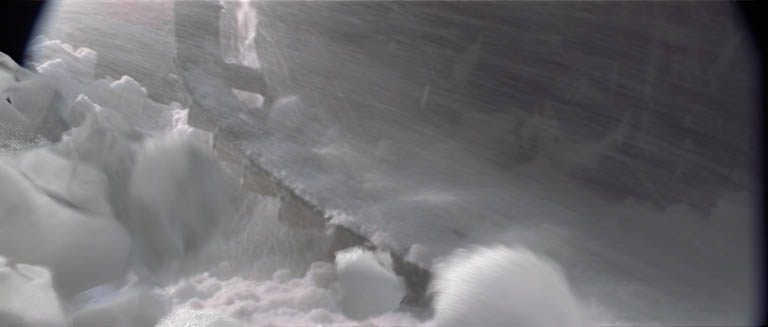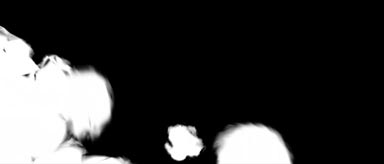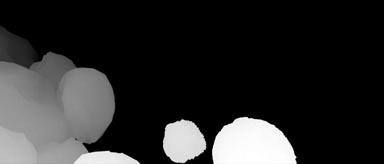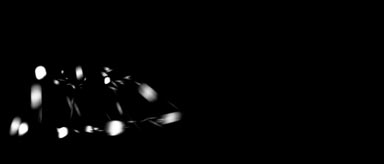This making-of is just for one shot. It's been done to show what we had to do, and what we did in order to complete the shot.
In
this shot, the SFX were supposed to re-create snow balls or rocks, snow
particles as a snowcrash is fleeding on the characters.
As the snow rocks gets accumulated behind the half-track, the snow pushes
it and pulls it from the ground.
All particles of snow are hardware, and all the snow rocks are software. I was in charge of all software shading and lighting on this project. Benoit Holl (from Mikros image) did the animation of the rocks and of the particles. The challenge of his work was to create a realistic animation of the blocks, some of them exploding in small parts when a collision occured with others rocks
Here is the background we worked on. Note that a 2d rotoscopy (of the half-track) has been done to make the shading easier, and to enhance the 3d rotoscopy.

The half-track is in the middle of the avalanche, protecting Jean Reno
and Vincent Kassel...

...but the pressure of the snow is too strong..
click here to see the original shot (divX)
We used nurbs spheres to create the base of the snow rocks. Once the vertices has been randomized a bit, they've been animated by Benoit Holl.
I took his scene, and applied a lighting on it according that the key light's coming from behind the half-track, the fill light fills the chains of the half-track, the overall intensity is helped with adding ambient lights. I've also created very ponctual lights to light very specific blocks or to simulate color transport from the ground.

As
the lighting is set, let get into the shading. The image references I
had to help me to do the shading shown me that obviously, I had to make
the edges transparent.This is done with a sampler info node, and the facing
ratio.
To create the color aspect, I have created a ramp fed with my color network.
I applied a noise to the ramp using HSV color noise. A displacement shader
is also used to generate some pertubations on our 'too basic' model.
Here is the 'generic' shader of the snow rocks.

Note that its a 'little' bit more complex than I explained above
(You don't think that I'll give you all my kitchen's secrets
like that...:-))
Now
the lighting and shading is done, the animation is validated, let's enter
into the rendering passes to give to the compositing (made on Inferno
& Shake). Benoit and I have split the rocks in 3 different scenes.
The first one is for the foreground blocks, and the second for the background
blocks. The third scene is for all little rocks...

RGB pass of the foreground blocks (pass calculated with the imagePlane
(actually a plane shaded with a surface shader with opacity gain to 0
to get properly the masks))


|
MASK
pass
|
Z-Depth pass to integrate all the passes |
The background pass has been calculated the same way...

RGB pass of the background blocks


|
MASK
pass
|
Z-Depth pass to integrate all the passes |
The third blocks pass is the little blocks (generated by the collisions of the bigger blocks...)


the passes have been calculated with mask and Z-Depth for compositing
Now let's get into the particles. Benoit did animate hardware multi-streaks emitted from the snow rocks. When you see the live footage (as references), small particles of snow are like water pourred over the rocks, so Benoit tried (successfully) to animate them, pourred over and from the big blocks, bouncing on the ground and on the other blocks.
See the playblast of these particles
(DivX compression) (800 Ko)
A last pass of 2d material (little snow streaks to 'fill' and enhance the realism of this shot) has been done in After Effects and then added in the final compositing
Finally, we have rendered and composed up to 15 different passes (snow rocks and particles) for that shot.
Here is the final look after compositing and color corrections...